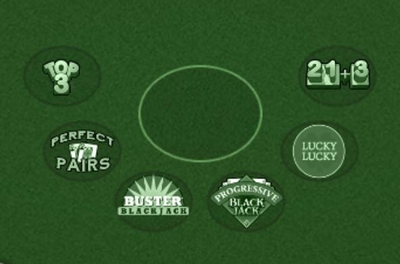 Blackjack is one of the most popular games at the casino, be that in Las Vegas, Cas Vegas (that’s Castleford, West Yorkshire for the uninitiated) or, more likely, online. Its simplicity is part of the reason for that appeal. Whilst perfecting basic strategy is far from straightforward and more complex techniques like card counting can be used, at its most basic level, all you have to do is beat the dealer.
Blackjack is one of the most popular games at the casino, be that in Las Vegas, Cas Vegas (that’s Castleford, West Yorkshire for the uninitiated) or, more likely, online. Its simplicity is part of the reason for that appeal. Whilst perfecting basic strategy is far from straightforward and more complex techniques like card counting can be used, at its most basic level, all you have to do is beat the dealer.
However, as well as the standard bet on your own hand, there are a range of games that can be played alongside the main bet. These are called side bets and range from standard options, usually offered in all blackjack variants and that are essentially part of the game itself, through to more complicated ones that are only found in certain versions of the game.
Here we take a look at all of the major blackjack side bets and explain how they work and what you need to know. Note that typically none of these can be placed as standalone bets, meaning you must be playing and staking for a normal hand in addition to any side bets you choose to place. In addition, it should be noted that many of the best online blackjack sites offer multiple side bets on the same hand, sometimes described as “All Bets Blackjack”. Such a variant of this iconic game will offer three or sometimes even more side bets and you can choose to back any or all of them alongside playing your hand.
Insurance
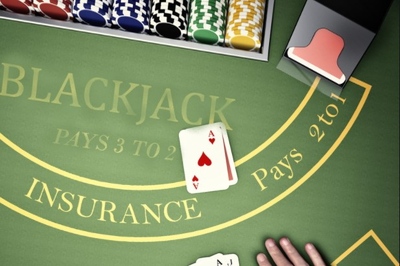 Insurance is a standard offering in virtually all forms of blackjack but is a side bet nonetheless. Once you have placed your primary stake, you will be offered insurance if the dealer’s up card is an ace. The maximum stake allowed is usually half of your initial stake and insurance pays out at odds of 2/1. If the dealer completes a natural (their second card is a 10 or face card) then your insurance bet wins. This means that if you lose your initial stake (which unless you too have a natural blackjack, you will) you will break even overall.
Insurance is a standard offering in virtually all forms of blackjack but is a side bet nonetheless. Once you have placed your primary stake, you will be offered insurance if the dealer’s up card is an ace. The maximum stake allowed is usually half of your initial stake and insurance pays out at odds of 2/1. If the dealer completes a natural (their second card is a 10 or face card) then your insurance bet wins. This means that if you lose your initial stake (which unless you too have a natural blackjack, you will) you will break even overall.
Assuming you are not counting cards you should not accept insurance as doing so hands a further advantage to the house. If you are counting cards and you know there are a high number of 10-value cards remaining in the shoe, and so the dealer is likely to hit their 21, you should accept the insurance. However, for most players, based on the simple maths of an unmonitored deck/shoe, it is a very bad bet.
People are often more inclined to take insurance when they have a strong hand, feeling that it would hurt more to lose. However, all things being equal the worst hand to take insurance on is a two-card 20. Even without counting cards, this tells us that there are already two 10-value cards out of the shoe and so the dealer’s chances of hitting one are therefore reduced.
Surrender
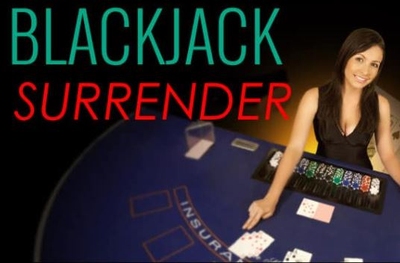 Surrender is a related “side bet” (it is not really a side bet as there is no additional stake) and is also one you will often see offered at “normal” blackjack tables. In a real-world casino, it can be worth checking if surrender is available as it is not always advertised, whilst online it will pop up as an option where applicable if it is available. Surrender allows you to end the hand early, folding in exchange for half your stake back. Its obvious application is when you believe you are likely to lose, so rather than play on and hand your entire stake to the casino, you surrender and lose just half.
Surrender is a related “side bet” (it is not really a side bet as there is no additional stake) and is also one you will often see offered at “normal” blackjack tables. In a real-world casino, it can be worth checking if surrender is available as it is not always advertised, whilst online it will pop up as an option where applicable if it is available. Surrender allows you to end the hand early, folding in exchange for half your stake back. Its obvious application is when you believe you are likely to lose, so rather than play on and hand your entire stake to the casino, you surrender and lose just half.
There are two forms of surrender, early and late, with early now rarely offered as it was deemed too player-favourable by casinos. You may still find it at the odd online casino and if you do it is well worth playing, assuming that all other rules are the same. Early surrender takes place before the dealer checks for blackjack, with late only possible afterwards (and only of course when they have discovered they do not have a natural).
Where late surrender exists it reduces the house edge (versus no surrender option) by between around 0.06% and 0.12% depending on how big an edge the casino has in general. That house edge, as with all quoted stats for blackjack, assumes you are playing to basic strategy. When it comes to surrendering, that means that to maximise your chances of success you need to know when to surrender and when not to.
Full strategy charts are available that explain this in more detail, with your decision on whether to surrender depending on what cards you hold and the dealer’s up card. Strategy changes according to the precise rules of the variant you are playing and also the number of decks used. In very simple terms, the most common times to surrender are when you have 16 and (separately) when the dealer has an ace, especially if they hit on soft 17. In both scenarios, the player should almost always surrender.
Perfect Pairs
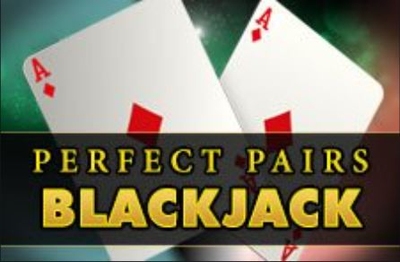 There are too many casinos in the world to count, and within these establishments, both online and offline, there are almost limitless blackjack variations. That means there are far too many blackjack side bets for us to cover them all in this piece, so we will instead focus on the most common ones. We believe there are at least 50 different side bets in blackjack, with some of these having sub-variants too, but we will instead look at the most mainstream ones you will typically find.
There are too many casinos in the world to count, and within these establishments, both online and offline, there are almost limitless blackjack variations. That means there are far too many blackjack side bets for us to cover them all in this piece, so we will instead focus on the most common ones. We believe there are at least 50 different side bets in blackjack, with some of these having sub-variants too, but we will instead look at the most mainstream ones you will typically find.
Perfect pairs very much falls into the mainstream category and generally speaking comes in two main guises. Probably the more common version of the side bet requires the player’s first two cards to be a pair. For any pair, you might get paid at 5/1 or 6/1, with a pair of the same colour typically being rewarded at 12/1 (though a range of 10/1 to 15/1 is possible). For a perfect pair, for example two aces of spades, you will be paid out at a very tidy 25/1, 30/1 or even 35/1. The precise rules and odds can vary and, all other things being equal, the higher the odds the better.
How much you can wager on the side bet varies, with some sites having no upper limit or minimum bet aside from the standard table one. The house edge on this side bet, as with virtually all side bets, is far higher than the normal game of blackjack itself. Depending on the exact rules in play and the odds offered, that edge can be as high as 10%, or even a little bit more. That’s a big difference, although with optimal rules it is closer to 2% and either way, some players feel the chance to land a 35/1 win is worth the extra juice for the casino.
The other version of perfect pairs, which you are more likely to see being referred to as “Perfect Pair”, is less common but does feature at several live dealer casinos. With eight decks this bet carries a house edge of 8%, increasing dramatically the fewer decks that are used.
Fundamentally the bet is very similar to the more common option but only pays out for a perfect pair (same suit and value). The other difference is that if both the player and the dealer hit a perfect pair on the same hand, the payout is a massive 200/1.
21 + 3
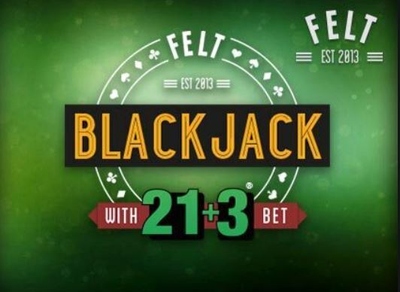 21+3 is a popular side bet that uses the player’s first two cards and the dealer’s up card.
21+3 is a popular side bet that uses the player’s first two cards and the dealer’s up card.
As with almost all side bets, there may be some variation from casino to casino in terms of the payout odds and thus the house edge. In general, however, you can expect a payout of 9/1, with the side bet winning if the three cards form any of the following hands: straight flush, straight, flush, three of a kind.
Typically in blackjack, the house edge is lower when fewer decks are used but this is often reversed when it comes to side bets. Based on the odds (payouts) above, the house edge for 21+3 with four decks is 4.24%, dropping to 3.24% with six decks and 2.74% with eight.
Variations of 21+3 include games where a pair is also a winning hand and others where the best hand is three of a kind of the same suit. In both cases, the odds for the various payouts change, with some iterations of this side bet paying the rarer hands at much higher odds, right up to 100/1 for a suited three of a kind.
Lucky Lucky
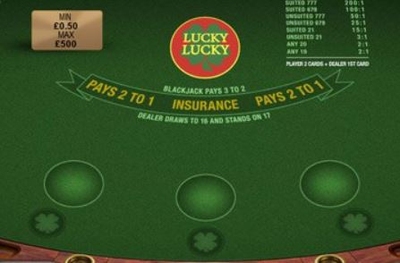 As with 21+3, Lucky Lucky – so lucky they named it twice – uses the player’s two cards and the dealer’s first to create a three-card side bet. This was, reportedly, the first game to be structured this way, with 21+3 and many others copying in years to come. Lucky Lucky has a relatively low house edge (for a blackjack side bet), with a figure of around 2.7% often stated as the lowest you are likely to see. As ever, different payouts for winning bets, the number of decks used and any rule tweaks alter this figure.
As with 21+3, Lucky Lucky – so lucky they named it twice – uses the player’s two cards and the dealer’s first to create a three-card side bet. This was, reportedly, the first game to be structured this way, with 21+3 and many others copying in years to come. Lucky Lucky has a relatively low house edge (for a blackjack side bet), with a figure of around 2.7% often stated as the lowest you are likely to see. As ever, different payouts for winning bets, the number of decks used and any rule tweaks alter this figure.
The winning combinations and how you will be rewarded will vary so make sure you check these first if you intend to take up a side bet. Where possible it is probably advisable to check the house edge – if this information is not provided you can always check with a member of the customer service team. You should be looking for a figure of around 5% or lower.
The highest paying hand for a Lucky Lucky side bet varies (it is usually three sevens of the same suit, though sometimes a 6, 7, 8 flush). The list below is just one example of the many that you will see that shows the various winning hands and the payouts.
- Three sevens, suited – pays at 200/1
- 6,7,8, suited – 100/1
- Three sevens, unsuited – 50/1
- 6,7,8, unsuited – 30/1
- Any total of 21, suited – 15/1
- Any total of 21, unsuited – 3/1
- Total of 20 or 19 – 2/1
This pay table is one of the more generous you will see thanks to the high maximum option of 200/1. Using these numbers, a game with six decks has a house edge of 2.66%. That said, we have seen some casinos offering Lucky Lucky with a 500/1 payout for a suited triple-seven hand, though they make this back in other areas. It is worth noting that the number of decks has a relatively low influence on the house edge with this side bet but in general (though not always) more decks results in a lower advantage for the house.
Bust/Buster Blackjack And Variants
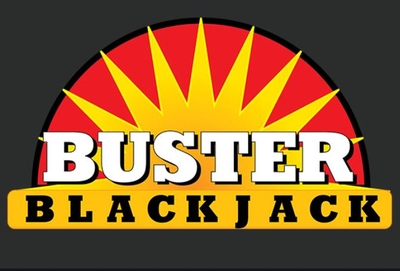 A lot of side bets depend on what hand you as the player make, some are about the dealer, whilst others are a mix of both hands. When it comes to the dealer’s cards, many side bets depend on the house busting with payouts structured in a range of ways depending on a number of factors.
A lot of side bets depend on what hand you as the player make, some are about the dealer, whilst others are a mix of both hands. When it comes to the dealer’s cards, many side bets depend on the house busting with payouts structured in a range of ways depending on a number of factors.
The most simple form of this side bet is a straight wager on whether or not the dealer will bust and usually pays out at 5/2 (in addition to the fact that you will also win your main hand assuming you have not already bust). The number of decks and whether or not the dealer hits or stands on soft 17 have a small impact on the probability of the dealer busting but, in general, there is around a 0.28 chance (28%) of them exceeding 21.
In certain theoretical circumstances (where the house hits soft 17 and six or fewer decks are being used) this can be a player-favourable side bet but, in general, the house edge is around 1.3%. This makes it one of the better side bets out there, though still typically worse than the game of blackjack itself.
Buster Blackjack is another fairly common side bet option and again, the bet wins if the casino busts. With Buster Blackjack the more cards the dealer has, the higher the payout, whilst some versions also increase the player’s winnings based on the player also hitting BJ. Various payouts are used, affecting the house edge, with a figure of around 6% typical, though this can rise as high as 13% or more with some Buster Blackjack variants that go by the name of Mega Blackjack at some online casinos.
An example payout table is shown below, though as said, there are many variations of this:
| Dealer’s Hand/Player Info | Payout |
|---|---|
| 8 or more cards and player has blackjack | 2000/1 |
| 7 cards and player has blackjack | 800/1 |
| 8 or more cards | 250/1 |
| 7 or more cards | 50/1 |
| 6 cards | 18/1 |
| 5 cards | 4/1 |
| 4 or 3 cards | 2/1 |
Bust Bonus is another related side bet; this one differs from most in that the player can choose to make the bet after seeing the dealer’s up card. The payout is determined by the dealer’s initial card, with the worst cards, such as a five or six, offering the lowest payouts and an ace the best, though most variants of this side bet pay highest if the dealer busts with three eights.
Progressive Blackjack
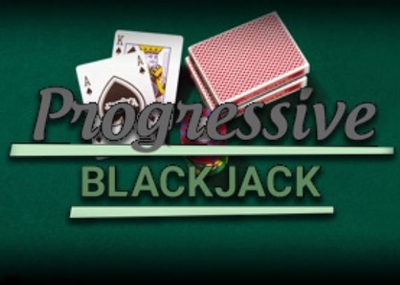 There are progressive versions of most casino games, with slots the most common and also potentially the most lucrative, with several huge seven-figure progressive slot wins. Whatever the game, the basis of progressive options is that a portion of your stake goes to the main, standard game, whilst a portion funds a much larger prize that rolls over and can usually be won at any linked slot/table.
There are progressive versions of most casino games, with slots the most common and also potentially the most lucrative, with several huge seven-figure progressive slot wins. Whatever the game, the basis of progressive options is that a portion of your stake goes to the main, standard game, whilst a portion funds a much larger prize that rolls over and can usually be won at any linked slot/table.
With blackjack, the progressive jackpot is typically funded by a direct side bet that makes you eligible for the jackpot. Due to the very large sums that can be won this way, the house edge is often very high, so this is not a bet to make if funds are low and you enjoy grinding it out for hours at the table. On the other hand, if you want to have the chance to win tens or even hundreds of thousands of pounds – or sometimes even more – and don’t mind giving up some juice to the house, such games are perfect.
Progressive blackjack usually centres on a player being dealt aces. To scoop the headline jackpot for a progressive game of blackjack you typically need your first four cards to be aces of the same suit or sometimes the same colour. Smaller, though still sizeable, jackpots are paid for four aces of any suit, three suited aces and so on.
The house edge on such games can be eye-watering and depending on the jackpot and pay table, figures of 40% upwards are not unheard of. That said, once the jackpot reaches a certain level, such side bets can actually be player-favourable. That may tempt some but even then, it should be remembered that only a single winner will feel the benefit of that, with huge variance between the many who play and lose, and the one lucky player who lands the progressive jackpot.
Blackjack Side Bets Conclusion
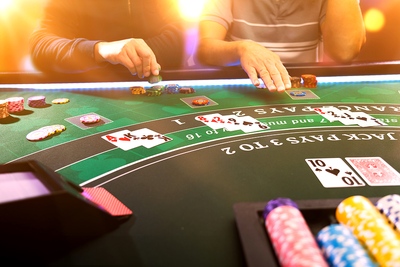 Most serious casino players will steer clear of side bets because the house edge is almost always far higher than it is for the core game.
Most serious casino players will steer clear of side bets because the house edge is almost always far higher than it is for the core game.
For expert card counters, there may be opportunities to exploit. However, for most people aiming to make a profit, or simply attempting to enjoy a long stay at the blackjack table whilst losing as little as possible, side bets are best avoided.
That said, whether you choose to play them depends on what your aims are and whether you are prepared to give up a substantial edge to gain the slim chance of a much larger win than even a natural blackjack can deliver.
Over a gambler’s blackjack “career” playing side bets will almost always result in more cash in the casino’s pocket and less in theirs.
However, in the short term, there is a chance that you may land a really big win, with payouts of 100/1 and sometimes even more available with certain blackjack side bets.
